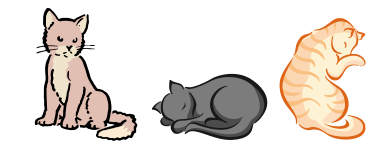Part of a Series: Here’s Why I Love Content Types: And You Should, Too
Concepts. Sets of objects, ideas, or events that have characteristics in common and share a common name. They can be concrete (discernable by our senses—car, truck, motorcycle) or abstract (defined by somebody—holiday, conference, leadership).

Clear Example of a Kitten
Why Concepts Are Important
For designers and teachers, concepts are essential.
-
Building Blocks. Concepts, like declarative knowledge, are another building block of learning. Imagine trying to learn the principles related to why it rains without having any idea what “rain,” “cloud,” “water vapor,” “air,” “warm,” and “cool” mean.Without acquiring basic concepts, learners will struggle to learn principles, procedures, or problem-solving methods.
- Triggers. We respond differently to a mountain lion than a house cat. Correctly categorizing a cat (or a person) as “friend” or “foe” helps us to determine what procedure to follow next (greeting, fight, flight).
- Shared Meaning. If we use the same concepts, then we can communicate. If not, well, not so much.
How to Teach a Concept
You’ll want to answer the question: Should people be able to tell this from that? Or this from everything else?
- (Usually) provide a definition. Note the critical attributes. For example, let’s look at a domestic cat.
a small domesticated carnivorous mammal with soft fur, a short snout, and retractile claws. It is widely kept as a pet or for catching mice, and many breeds have been developed
American Oxford Dictionary - Show clear examples and clear nonexamples.
- Clear examples are those that obviously fit the definition. Point out the critical attributes. For example: small, mammal, carnivorous, soft furred, short snout, retractile claws.

- Clear nonexamples have something in common with the concept, but definitely, obviously do not fit the concept. Point out which critical attributes are missing.

- Clear examples are those that obviously fit the definition. Point out the critical attributes. For example: small, mammal, carnivorous, soft furred, short snout, retractile claws.
- Once your learners have mastered clear examples and nonexamples, show divergent (less obvious) examples and close-in (less obvious) nonexamples.
-
Divergent examples are those that still fit the concept, but our learners may not see that at first. Showing a range of examples helps the learner to identify examples that she would otherwise miss.Be sure to point out the variable attributes (characteristics that may be different from cat to cat). For example: coat color, markings, length of fur, eye color, disposition, age, size (within reason), minor variations of ear size and placement, eye shape, and build.

-
Close-in nonexamples almost fit the concept, but they lack just one or maybe two of the critical attributes—these could be confused with the concept. Showing a range of nonexamples helps the learner to exclude similar but not-quite-right possibilities.

-
- Test. You’ll know your learner has acquired a concept when he can correctly classify potential instances as examples or nonexamples. Show unfamiliar instances and ask whether they belong to the concept, or not.
Another way to test is to have the learners gather and classify their own examples. If they can tell you why a particular instance fits the concept (or doesn’t), this can be useful, too.
Cautions
Avoid useless nonexamples. These have so little in common with the attributes of the concept that they do not help the learner to distinguish between instances that belong to the concept and those that do not. These just waste everybody’s time.

It’s Not So Much about Memory. Memorizing a definition is not the same as acquiring a concept. The first is declarative knowledge: the ability to remember and repeat a definition. The second is being able to sort or classify instances accurately into examples and nonexamples of a particular concept. We are mostly looking for this second skill with concept knowledge.
Spend Enough Time. With concept learning, the most important thing is for learners to recognize new instances of the concept and classify them correctly. The definition is rarely enough. Before teaching procedures or problem solving, be sure your learners have acquired the concepts they’ll need to get the job done.
Watch for overgeneralization (including too many) and under-generalization (not including enough). Provide enough practice and feedback so that your learners can avoid either one.
We use concepts all day long. For example: Is this way of putting something respectful or dismissive? It that a pile of trash or a work in progress? Is this joke harmless or hazing? Is this sentence a learning objective or a learning activity description?
We use definitions, critical and variable attributes, and sets of many different examples to teach concepts. Sorting activities work well, whether low tech (real objects, card sorts, or descriptions) or high tech (online or via games). You should provide a wide variety of relevant examples. Once they can sort those, encourage learners to find their own.
When they’re essential for more complex tasks, ensure that learners “get” the concepts they’ll need to do those tasks well.
Resources
Post | Here’s Why I Love Content Types: And You Should, Too
Post | Learning to Spout Stuff—Necessary, But Seldom Sufficient
